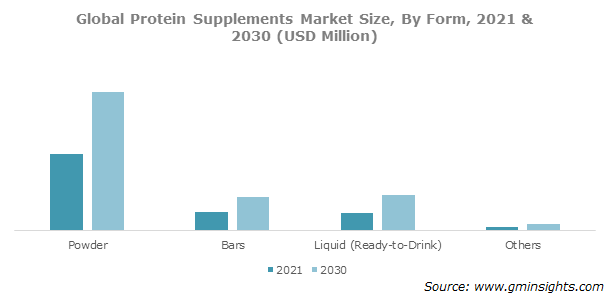Home > Healthcare > Pharmaceuticals > Clinical Nutrition > Protein Supplements Market
Protein Supplements Market Analysis
- Report ID: GMI5292
- Published Date: Jul 2022
- Report Format: PDF
Protein Supplements Market Analysis
The powder segment held a dominant market share in 2021 and is expected to reach around USD 11,114 million by 2030 owing to several advantages offered by powder protein supplements for athletic and non-athletic individuals. As nutrition is one of the important pillars for good physical and mental health, protein powder plays an essential role in completing the everyday nutrition of the body. Protein deficiency is one of the major causes of several diseases including cachexia, kwashiorkor and marasmus, among others.
For instance, according to the reports published by the Journal of Parenteral and Enteral Nutrition, in 2021, stated that approximately 80% of the total cancer patients developed cachexia in Europe and accounted around 20% mortality rate due to inadequate nutritional intake.
These diseases are generally treated by increasing the nutritional count in the body. Several physicians and doctors recommend the use of protein supplements in powder form due to better absorption rate and faster mechanism of action. Therefore, the use of powder protein supplements for better clinical results is set to increase the market growth in the estimated timeframe.
Based on source, the animal-based segment held a dominating market share and accounted for around USD 5,891 million in 2021 owing to clinical advantages offered by animal-based protein supplements influencing the product adoption among several undernourished patients. Animal based protein supplements have higher protein content as compared to plant base protein supplements. These supplements are an easier method of consuming essential amino acids that help to stimulate muscle synthesis and speed the muscle recovery. Soy protein ingredients market size to cross USD 15.7 billion by 2032.
For instance, according to the recommend standards by the U.S. FDA, every serving of animal-based protein supplement (39g) contains minimum 26g of protein for adults consuming 2,000 calories diet. Additionally, these supplements enhance the immunity among patients suffering from chemotherapy by increasing their glutathione levels. Thus, the soaring demand and availability of animal-based protein supplements are set to facilitate market growth incrementally. Pea protein market size will reach USD 480 million by 2032.

Based on distribution channel the supermarket & hypermarkets segment held a substantial market share in 2021 and is estimated to show a lucrative growth rate at 7.4% CAGR from 2022 to 2030 due to availability of wide varieties of protein supplements in the supermarkets & hypermarkets. Strong distribution channels and extensive network of suppliers to these stores assists to reach a wide customer base and manage consumer compliance.
Expansion strategies adopted by superstores such as Walmart and Target among others that have special sections for protein supplements are driving the product adoption rate among the customers. There are over 5,335 stores of Walmart in the U.S. that provide protein supplements that cater to a wide range of customers including infants, children, adults and geriatric population.

U.S. dominated the North America protein supplements market in 2021 and is anticipated to expand at a significant pace to reach more than USD 6,807 million by 2030 owing to several factors including presence of major market players, an increase in the demand for protein supplements, increasing fitness centers, etc. Several market players in the region are engaged in new product development & commercialization that facilitates the protein supplements industrial expansion in the region.
According to the reports of the Center for Diseases Control Prevention (CDC), in 2021, an estimation of around 42 million people in the U.S. are protein deficient and suffering from malnutrition thereby leading to several chronic disorders. Several government and NGO’s have carried out various promotional campaigns for awareness of protein supplements and their benefits. Thus, the above-mentioned factors are projected to boost the U.S. protein supplements market growth during the analysis timeframe.

